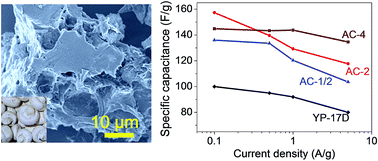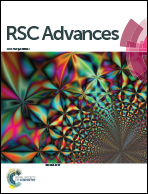Fungi-derived hierarchically porous carbons for high-performance supercapacitors†
Abstract
Hierarchical porous activated carbons (ACs) were prepared via a chemical activation procedure with sustainable, renewable biomass fungi as carbon precursor and KOH as activating reagent. The as-produced porous ACs present not only a hierarchical porous structure containing macroporous frameworks and microporous textures, but also a high specific surface area of up to 2264 m2 g−1, a large pore volume of up to 1.02 cm3 g−1, and adjustable heteroatom doping (nitrogen: 2.15–4.75 wt%; oxygen: 8.53–14.48 wt%). The microstructural features can be easily controlled by adjusting the mass ratio of KOH/carbon precursor. The porous ACs possess a specific capacitance of up to 158 F g−1 in organic electrolyte, which significantly outperforms the commercially available ACs. The fungi-based ACs electrode also retains 93% of the specific capacitance as the current density increases from 0.1 to 5 A g−1, and has superior cycling performance (92% retention after 10 000 cycles).


 Please wait while we load your content...
Please wait while we load your content...